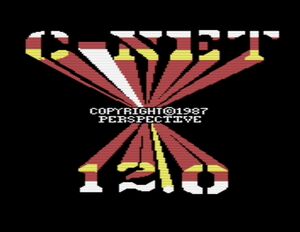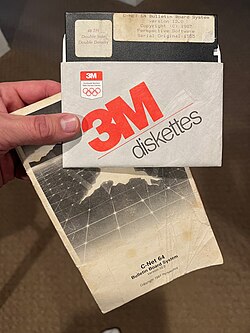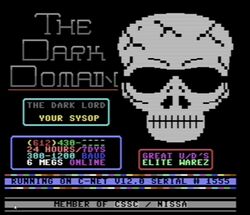Software:C-Net 12.0: Difference between revisions
Importwiki (talk | contribs) (import) |
Importwiki (talk | contribs) (import) |
||
| Line 22: | Line 22: | ||
}} | }} | ||
'''C-Net 12.0''' (C-Net 64) was a full featured, single-line, [[Bulletin board system|bulletin board system]] (BBS) software system released in 1987 for the [[Engineering:Commodore 64|Commodore 64]] microcomputer by Perspective Software. It was based on C-Net 10.0 written by Ken Pletzer and was coded by Don Gladden and Ray Kelm.<ref name="Image"/> <ref name="Sub"/> | '''C-Net 12.0''' (C-Net 64) was a full featured, single-line, [[Bulletin board system|bulletin board system]] (BBS) software system released in 1987 for the [[Engineering:Commodore 64|Commodore 64]] microcomputer by Perspective Software.<ref name ="OrigCnetReleaseNotes"/> It was based on C-Net 10.0 written by Ken Pletzer and was coded by Don Gladden and Ray Kelm.<ref name ="OrigCnetReleaseNotes"/> <ref name="Image"/> <ref name="Sub"/> It originally sold for $64.95 or a upgrade from V10 or V11 for $35.00.<ref name="OrigCnetPriceSheet"/> | ||
C-Net 12.0 was one of the most powerful and flexible BBS program available for Commodore computers.<ref name="Zimmer"/> It was written mostly in BASIC, so it is very easy to modify. The editor, I/O routines and other speed-intensive modules are written in machine language for speed. | C-Net 12.0 was one of the most powerful and flexible BBS program available for Commodore computers.<ref name="Zimmer"/> It was written mostly in BASIC, so it is very easy to modify.<ref name ="OrigCnetReleaseNotes"/> The editor, I/O routines and other speed-intensive modules are written in machine language for speed. | ||
One unique feature of C-Net is "P-Files", or program modules. These enable C-Net to run unrestricted by the memory limitations of Commodore computers. Basically, C-Net keeps a | One unique feature of C-Net is "P-Files",<ref name ="OrigCnetReleaseNotes"/> or program modules. These enable C-Net to run unrestricted by the memory limitations of Commodore computers. Basically, C-Net keeps a | ||
"main program" in memory that contains the basic C-Net functions and routines like the main menu and the commands available from all levels. Then, it loads in a "P-File" for whatever subsystem you are using.<ref name="Prg"/> An official P-File disk was available from Perspective for $18.95. Among the many P-Files that were created, WallWriter and Voting Booth by John Moore (aka Little John) were some of the more popular. | "main program" in memory that contains the basic C-Net functions and routines like the main menu and the commands available from all levels. Then, it loads in a "P-File" for whatever subsystem you are using.<ref name="Prg"/> An official P-File disk was available from Perspective for $18.95.<ref name="OrigCnetPriceSheet"/> Among the many P-Files that were created, WallWriter and Voting Booth by John Moore (aka Little John) were some of the more popular. | ||
Hundreds of P-File games were also created. Some popular ones were Murder Motel, Empire, Dragon World, Battle and Orion. C-Net 12.0 also had a flexible security model and fully customizable sub boards, upload/download areas and e-mail. It also used MCI (Message Command Interpreter) commands to handle graphics. [[PETSCII]] art was also a popular creative outlet on BBSs of this era. | Hundreds of P-File games were also created. Some popular ones were Murder Motel, Empire, Dragon World, Battle and Orion. C-Net 12.0 also had a flexible security model and fully customizable sub boards, upload/download areas and e-mail.<ref name ="OrigCnetReleaseNotes"/> It also used MCI (Message Command Interpreter) commands to handle graphics.<ref name ="OrigCnetReleaseNotes"/> [[PETSCII]] art was also a popular creative outlet on BBSs of this era. | ||
C-Net 12.0 was not based on C-Net 11.0/11.1a but was based primarily on C-Net 10.0 written by Ken Pletzer. <ref name="Image"/> Version 11.x, which was written by Jim Selleck, was succeeded by C-Net 11.6.<ref name="Sub"/> Which was eventually rebranded as [[Software:C-Net DS2|C-Net DS2]]. After Several versions of DS2, it was acquired by Storm’s Edge Technologies in 2012.<ref name="DS2"/> | C-Net 12.0 was not based on C-Net 11.0/11.1a but was based primarily on C-Net 10.0 written by Ken Pletzer. <ref name="Image"/> Version 11.x, which was written by Jim Selleck, was succeeded by C-Net 11.6.<ref name="Sub"/> Which was eventually rebranded as [[Software:C-Net DS2|C-Net DS2]]. After Several versions of DS2, it was acquired by Storm’s Edge Technologies in 2012.<ref name="DS2"/> | ||
| Line 37: | Line 37: | ||
[[File:C-Net_12.0_BBS_Login_Screen_for_The_Dark_Domain_BBS.jpg|thumb|Example login screen of a BBS running C-Net 12.0]] | [[File:C-Net_12.0_BBS_Login_Screen_for_The_Dark_Domain_BBS.jpg|thumb|Example login screen of a BBS running C-Net 12.0]] | ||
The C-Net family of BBSs were supported nationwide by a dedicated group of sysops known as the C-Net Sysop Support Center (CSSC). This group was headed up by Fred Dart (aka The Chief), John Moore (aka Little John), Gear Jammer and others around the country.<ref name="Image"/> | The C-Net family of BBSs were supported nationwide by a dedicated group of sysops known as the C-Net Sysop Support Center (CSSC).<ref name="Cnetmodpack1"/><ref name="Cnetmodpack2"/> This group was headed up by Fred Dart (aka The Chief), John Moore (aka Little John), Gear Jammer and others around the country.<ref name="Image"/> While there was not official headquarters for the CSSC, Port Commodore BBS, run by Fred Dart, was one of the main places to find these fixes. <ref name="Cnetmodpack1"/><ref name="Cnetmodpack2"/> | ||
Using the CSSC network, they would share fixes and modifications that sysops could make to their own code. Sysops across the country created their own P-Files that could be incorporated into other BBSs if the sysops chose too.<ref name="Cnetmodpack1"/><ref name="Cnetmodpack2"/> Because of this, C-Net 12.0 BBSs could look very different from each other. | |||
During the summer of 1988, version 12.1 (also written by Don Gladden) was set to be released as a $7.98 upgrade.<ref name="WNF"/> During this time Don Gladden left Perspective Software and took 12.1 with him. After a few changes, it was rebranded as Image BBS 1.0. The CSSC was replaced with NISSA (The New Image Sysop Support Association). C-Net 12.1 would eventually be released by Perspective Software. | During the summer of 1988, version 12.1 (also written by Don Gladden) was set to be released as a $7.98 upgrade.<ref name="WNF"/> During this time Don Gladden left Perspective Software and took 12.1 with him. After a few changes, it was rebranded as Image BBS 1.0.<ref name="Image"/><ref name="WNF"/> The CSSC was replaced with NISSA (The New Image Sysop Support Association). C-Net 12.1 would eventually be released by Perspective Software. | ||
== References == | == References == | ||
{{reflist|refs= | {{reflist|refs= | ||
<ref name="OrigCnetPriceSheet">{{cite book |title=C-Net Price Sheet by Perspective Software}}</ref> | |||
<ref name="OrigCnetReleaseNotes">{{cite book |title=C-Net 12.0 Release Notes by Perspective Software}}</ref> | |||
<ref name="Cnetmodpack1">{{cite book |title=C-Net 12.0 Mod Pack 1 (CSSC) Release Notes - November 1987}}</ref> | |||
<ref name="Cnetmodpack2">{{cite book |title=C-Net 12.0 Mod Pack 2 (CSSC) Release Notes - February 1988}}</ref> | |||
<ref name="Image">{{cite web |url=https://www.zimmers.net/bbs/docs/image.html |title=History of Image BBS by Fred Dart}}</ref> | <ref name="Image">{{cite web |url=https://www.zimmers.net/bbs/docs/image.html |title=History of Image BBS by Fred Dart}}</ref> | ||
| Line 60: | Line 69: | ||
}} | }} | ||
== External links == | |||
* [https://www.youtube.com/watch?v=VgTZjQTYwY4&t=406s&pp=ygULYy1uZXQgc3lzb3A%3D Introduction to C-Net 12.0] | |||
* [https://www.youtube.com/watch?v=jsT37kK0eVs&t=468s&pp=ygULYy1uZXQgc3lzb3A%3D Configuring C-Net 12.0] | |||
* [https://www.youtube.com/watch?v=HxLKJ-a0g-c&t=1037s&pp=ygULYy1uZXQgc3lzb3A%3D The first login to C-Net 12.0] | |||
Latest revision as of 08:19, 20 April 2024
 C-Net 12.0 loading screen | |
| Original author(s) | Perspective Software |
|---|---|
| Developer(s) | Don Gladden and Ray Kelm |
| Initial release | 1987 |
| Written in | BASIC |
| Platform | C64 |
| Predecessor | C-Net 11.1a |
| Successor | C-Net 12.1 |
| Size | Single 5.25 floppy |
| Available in | English |
| Type | BBS Software |
| License | $64.95, $35 for Upgrade from v10 or v11 |
C-Net 12.0 (C-Net 64) was a full featured, single-line, bulletin board system (BBS) software system released in 1987 for the Commodore 64 microcomputer by Perspective Software.[1] It was based on C-Net 10.0 written by Ken Pletzer and was coded by Don Gladden and Ray Kelm.[1] [2] [3] It originally sold for $64.95 or a upgrade from V10 or V11 for $35.00.[4]
C-Net 12.0 was one of the most powerful and flexible BBS program available for Commodore computers.[5] It was written mostly in BASIC, so it is very easy to modify.[1] The editor, I/O routines and other speed-intensive modules are written in machine language for speed.
One unique feature of C-Net is "P-Files",[1] or program modules. These enable C-Net to run unrestricted by the memory limitations of Commodore computers. Basically, C-Net keeps a "main program" in memory that contains the basic C-Net functions and routines like the main menu and the commands available from all levels. Then, it loads in a "P-File" for whatever subsystem you are using.[6] An official P-File disk was available from Perspective for $18.95.[4] Among the many P-Files that were created, WallWriter and Voting Booth by John Moore (aka Little John) were some of the more popular.
Hundreds of P-File games were also created. Some popular ones were Murder Motel, Empire, Dragon World, Battle and Orion. C-Net 12.0 also had a flexible security model and fully customizable sub boards, upload/download areas and e-mail.[1] It also used MCI (Message Command Interpreter) commands to handle graphics.[1] PETSCII art was also a popular creative outlet on BBSs of this era.
C-Net 12.0 was not based on C-Net 11.0/11.1a but was based primarily on C-Net 10.0 written by Ken Pletzer. [2] Version 11.x, which was written by Jim Selleck, was succeeded by C-Net 11.6.[3] Which was eventually rebranded as C-Net DS2. After Several versions of DS2, it was acquired by Storm’s Edge Technologies in 2012.[7]
When purchased, the buyer would receive a single 5.25 Floppy disk, instruction manual and a dongle to prevent piracy. This dongle would plug in to joystick port 2. [8]
The C-Net family of BBSs were supported nationwide by a dedicated group of sysops known as the C-Net Sysop Support Center (CSSC).[9][10] This group was headed up by Fred Dart (aka The Chief), John Moore (aka Little John), Gear Jammer and others around the country.[2] While there was not official headquarters for the CSSC, Port Commodore BBS, run by Fred Dart, was one of the main places to find these fixes. [9][10] Using the CSSC network, they would share fixes and modifications that sysops could make to their own code. Sysops across the country created their own P-Files that could be incorporated into other BBSs if the sysops chose too.[9][10] Because of this, C-Net 12.0 BBSs could look very different from each other.
During the summer of 1988, version 12.1 (also written by Don Gladden) was set to be released as a $7.98 upgrade.[11] During this time Don Gladden left Perspective Software and took 12.1 with him. After a few changes, it was rebranded as Image BBS 1.0.[2][11] The CSSC was replaced with NISSA (The New Image Sysop Support Association). C-Net 12.1 would eventually be released by Perspective Software.
References
- ↑ 1.0 1.1 1.2 1.3 1.4 1.5 C-Net 12.0 Release Notes by Perspective Software.
- ↑ 2.0 2.1 2.2 2.3 "History of Image BBS by Fred Dart". https://www.zimmers.net/bbs/docs/image.html.
- ↑ 3.0 3.1 "CNET 64 Petscii Forum". https://jledger.proboards.com/thread/496/.
- ↑ 4.0 4.1 C-Net Price Sheet by Perspective Software.
- ↑ "CNet history by Zimmers". https://zimmers.net/bbs/cnbbs.html.
- ↑ "C-Net 12.0 P-File Modifiers Guide". https://commodore.software/downloads/download/468-c-net/13396-c-net-bbs-v12-p-file-modifiers-guide.
- ↑ "CNet DS II History". https://www.cnet64.com/where-it-all-start/.
- ↑ "C-Net 12.0 User Manual". https://commodore.software/downloads/download/468-c-net/16091-c-net-64-bbs-v12-0-manual.
- ↑ 9.0 9.1 9.2 C-Net 12.0 Mod Pack 1 (CSSC) Release Notes - November 1987.
- ↑ 10.0 10.1 10.2 C-Net 12.0 Mod Pack 2 (CSSC) Release Notes - February 1988.
- ↑ 11.0 11.1 "History of The Wrong Number BBS by Al Derosa". https://www.wrgnbr.com/pdf/WNFhistory.pdf.
External links
Category:Bulletin board system software
 |



